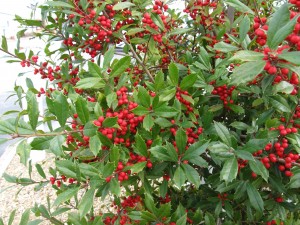Foster holly (Ilex x attenuata) is an old holly favorite which has not lost its sizzle. While many new holly cultivars have entered the landscape scene, do not assume that Foster holly is now passé. It is utilized in a number of landscape options in the Southern Appalachian region (USDA zones 6 and 7), including in containers in zones 7 and 8.
Foster Holly Has It All
Originally, there were five selections of Foster holly introduced by E. E. Foster of Foster Nursery, Bessemer, AL in the 1940’s. Still the most popular today is ‘Foster #2’, a female clone which produces a bounty of small bright red holly berries. Fruits continue to be effective throughout the winter. ‘Foster #4’ is its male pollinator mate, but in most locales, male American hollies (Ilex opaca) will also pollinate Foster #2.
Holly (Ilex spp.) grows in a moderately acidic (pH 5.8 – 6.5), well-drained soil and in full to partial sunlight. Feed with a water-soluble acidic fertilizer such as Miracle –Gro™, Miracid™, or Hollytone®.
Foster hollies display a strong vertical accent when utilized as specimen or foundation shrubs in front of tall buildings or on the corners of residences. They form a 12–20-foot dense evergreen privacy screen and may be sheared as hedges. Tall overgrown Foster hollies may be cutback severely in early spring for a small compact size. Heavy clipping can transform them into almost any topiary shape that you desire.


 Posted in
Posted in 
